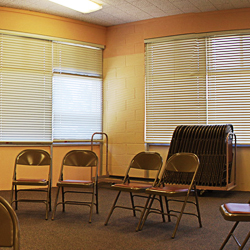
3. Priority Navel Communication!
Notice I said “navel” and not “naval.” I’m not talking about seafaring issues; I’m talking about singers using bad mic techniques.
The smaller the sanctuary, the easier it is for singers (and speakers) to think their vocal microphone is less important.
Therefore, instead of holding it right up to their mouth, they hold it much farther away – sometimes by their navel. At this point, it’s hard to pick up much of anything in the microphone.
This is a training issue in which you need to explain to singers/speakers that while the room may be small, their voice can easily disappear in the mix and the congregation finds it hard to follow along.
This is especially true of new songs. And just like the piano without a microphone, if they aren’t singing into the microphone, you can’t put it in the monitors for other musicians to hear.
4. Drum roll, please
The drums can be one of the biggest pains in the, in the, um…the drums can be a pain to mic in a small room. Do you mic every drum kit piece? Do you mic nothing?
This is where you need to spend time testing out different drum mic’ing techniques and determine which gives you the best overall sound and control.
You should at least use a single overhead microphone placed about a foot over the drummer and pointed at the drum kit. You won’t get the thump of the kick drum but you’ll have the ability to work a bit of EQ and volume on the snare and the cymbals.
If you check out Microphone World here on ProSoundWeb you can read all about the different drum mic’ing techniques, which you can also find in my free ebook.
5. Feedback frenzy!
I’d be remiss not to mention feedback issues in a small room.
A small room usually means a small stage. A small stage means vocal microphones are in close proximity to the monitors. This is where it’s crucial you have proper monitor levels and proper vocal mic technique by the singers.
The feedback issue I usually see (hear) is when a singer lowers their microphone by their side and places it inline with the floor monitor.
6. Let’s call this bonus #6
Not long ago, I had the stage set up and wasn’t getting the right sound from the kick drum.
As it turned out, the floor monitor for a guitarist was being shared with the drummer and the kick drum mic was inline with the monitor. So, the drum mic was picking up the monitor sounds.
Now this was a simple change in monitor location before the gig. Therefore, be careful where your monitors are pointing because those instrument microphones might pick up more than you want.
What problem have you experienced in a small room/small sanctuary? How did you overcome it? Be sure to let us know in the comments below!
Ready to learn and laugh? Chris Huff writes about the world of church audio at Behind The Mixer. He covers everything from audio fundamentals to dealing with musicians. He can even tell you the signs the sound guy is having a mental breakdown.
